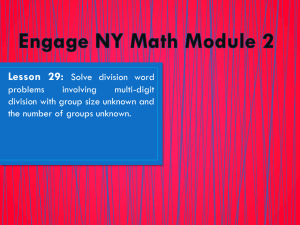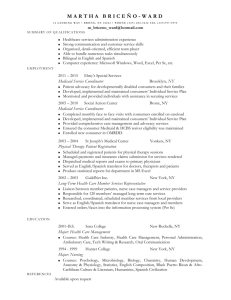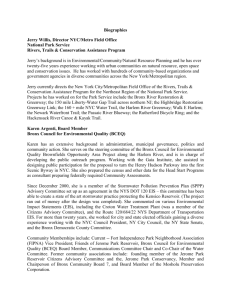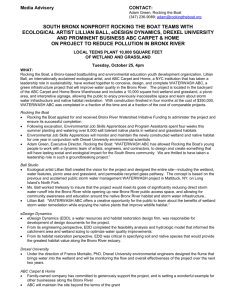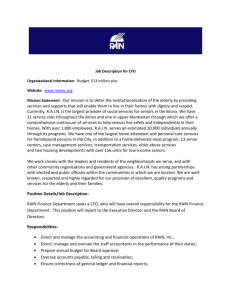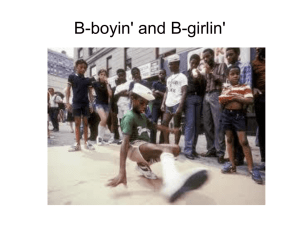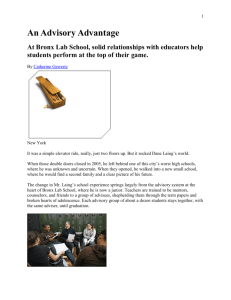statement of community district needs for fiscal year 2016
advertisement
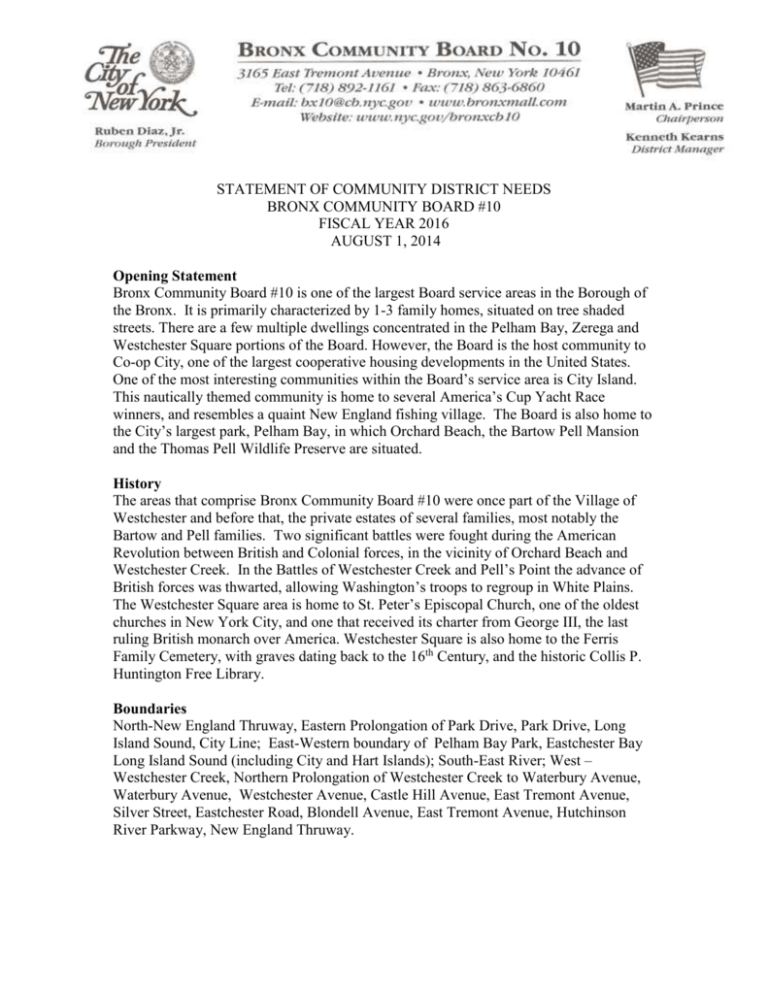
STATEMENT OF COMMUNITY DISTRICT NEEDS BRONX COMMUNITY BOARD #10 FISCAL YEAR 2016 AUGUST 1, 2014 Opening Statement Bronx Community Board #10 is one of the largest Board service areas in the Borough of the Bronx. It is primarily characterized by 1-3 family homes, situated on tree shaded streets. There are a few multiple dwellings concentrated in the Pelham Bay, Zerega and Westchester Square portions of the Board. However, the Board is the host community to Co-op City, one of the largest cooperative housing developments in the United States. One of the most interesting communities within the Board’s service area is City Island. This nautically themed community is home to several America’s Cup Yacht Race winners, and resembles a quaint New England fishing village. The Board is also home to the City’s largest park, Pelham Bay, in which Orchard Beach, the Bartow Pell Mansion and the Thomas Pell Wildlife Preserve are situated. History The areas that comprise Bronx Community Board #10 were once part of the Village of Westchester and before that, the private estates of several families, most notably the Bartow and Pell families. Two significant battles were fought during the American Revolution between British and Colonial forces, in the vicinity of Orchard Beach and Westchester Creek. In the Battles of Westchester Creek and Pell’s Point the advance of British forces was thwarted, allowing Washington’s troops to regroup in White Plains. The Westchester Square area is home to St. Peter’s Episcopal Church, one of the oldest churches in New York City, and one that received its charter from George III, the last ruling British monarch over America. Westchester Square is also home to the Ferris Family Cemetery, with graves dating back to the 16th Century, and the historic Collis P. Huntington Free Library. Boundaries North-New England Thruway, Eastern Prolongation of Park Drive, Park Drive, Long Island Sound, City Line; East-Western boundary of Pelham Bay Park, Eastchester Bay Long Island Sound (including City and Hart Islands); South-East River; West – Westchester Creek, Northern Prolongation of Westchester Creek to Waterbury Avenue, Waterbury Avenue, Westchester Avenue, Castle Hill Avenue, East Tremont Avenue, Silver Street, Eastchester Road, Blondell Avenue, East Tremont Avenue, Hutchinson River Parkway, New England Thruway. Page -2Public Safety Bronx Community Board #10 is serviced by the 45th Precinct, which has one of the largest patrol areas in the City, over 6 miles. One of the greatest challenges to law enforcement in Community Board #10 is the illicit drug trade. The drug trade in this Precinct is characterized by internet sales, the use of unregistered cell phones, and automobiles. The 45th Precinct at one time had a full drug module assigned to it. However, it has since been split with the 43rd Precinct. Bronx Community Board #10 has long advocated for the permanent re-assignment of this module back to the 45th Precinct. The sophisticated nature of the drug trade in this Board’s service area requires the reassignment of this module to the 45th Precinct. Additionally, the 45th Precinct has historically suffered from understaffing. Its patrol sector is quite large, spanning the distance from Zerega Avenue to Co-op City. Its officers are pulled for special duties at Orchard Beach, Yankee Stadium, or to other venues throughout the City. This reduces the overall number of officers that are available for patrol, on any given day. It is our Board’s sincere hope that the senior management of the New York City Police Department recognizes the staffing disparities at the 45th Precinct and makes the necessary adjustments, so that this Precinct is staffed properly at all times and our Board is served well. In speaking about staffing, for over forty years the NYPD has relied on the Rand Formula to determine staffing for the Precincts. Principally, high crime precincts get the most officers. This is an old and outdated tool of analysis, it is a reactive model. What is needed is a tool for personnel analysis, one that is reflective of modern policing that is proactive, with respect to crime. Graffiti is still a major problem within the Board’s service areas. The Board works with the 45th Precinct’s graffiti officer in identifying sites for further investigation and enforcement. In addition, it works with the City and elected officials on programs designed to remove the offensive scrawling. The Board will embark upon a new initiative designed to have community observers report graffiti, directly to the Board Office, which will serve as a clearing house. The Board Office will file the requests to clean the sites with the City’s program and that of locally elected officials. It is hoped that the graffiti will be removed in a more systematic fashion. Speeding is a recognized problem within the Board’s service areas. With the establishment of Vision Zero, speed limits have been reduced to 25 miles per hour. The speed reduction initiatives such as traffic calming and slow zones, combined with lower speeds, will result in safer streets for everyone. The Board is confident that the City has adequate traffic regulations. However, with those traffic regulations, there must be robust enforcement. The Board supports the hiring of additional officers for this purpose. FDNY There are a number of fire houses within the Board’s service area that are undergoing renovation. The Board has been supportive of these renovations and continues to do so. Page -3- Transportation Bronx Community Board #10 has witnessed the arrival of two mega malls, with a third one planned, and the Ferry Point Park Golf Course. There was little, if any, attention paid by the developers to the establishment of a rational traffic plan for any of these entities. Only after the owners of the Bay Plaza Mall realized that the mall’s expansion of seventy-five stores, making it the largest mall in the City, lacked an adequate entrance from the New England Thruway, was a plan to expand the entrances arrived at by the City, State and mall’s owners. There is still no traffic plan regarding any exits from this facility. The existing body of zoning regulations and traffic laws make no provision for such planning. The attitude of “if you build it, they will come,” holds sway in the halls of commerce and government. This makes no sense at all and the City and State governments must pass legislation that brings rationality to the development market. At the very minimum, laws should be in place creating a regulatory environment allowing for regional planning, community benefit packages and rational traffic planning. Presently, the road network is viewed as a static entity. There is no long term planning associated with the ability of a particular road to absorb changes in its fluid environment (the communities along its route). A road is only changed after announced development, and then inadequately. Every five years or so, the route of a road and the communities that it serves should be reviewed and assessed for potential development. In this way, we will not have spotty road renovations to accommodate a single developer. The Board’s network of roads, the Bruckner Expressway, the Cross Bronx Expressway , the New England Thruway and the Hutchinson River Parkway are all subject to constant traffic flow. These roads are outdated and require constant maintenance. The entire network of roadway, exits, entrances and transfer points must be analyzed and reevaluated to ensure both an easy flow of traffic and safe ride for those who use them. Alternatives to road travel for commercial purposes should be seriously reviewed. Existing rail to road access points should be considered, as well as water to rail to road access points for freight. The Board is grateful to note that the Metro-North Railroad has expressed an interest in bringing rail passenger service to the Northeast Bronx by establishing a station at Co-op City, in Section #5. The Board has long advocated for this station and enthusiastically supports this concept. The Board has adopted a Resolution to this affect. It is hoped that passenger train service between Co-op City and Pennsylvania Station and Grand Central Station will soon become a reality. The Board has also advocated for commuter ferry service to serve Co-op City and other areas of the northeast Bronx. Health and Human Services Bronx Community Board #10 is serviced by the Jack D. Weiler Hospital of Montefiore Hospital, Jacobi Hospital, and the Emergency Care Unit of Montefiore at Westchester Square. The Board service area is also replete with doctors’ offices and medical facilities. Yet, our Board still suffers from high rates of low birth weight babies, obesity, diabetes, alcoholism, and drug abuse. The Board has taken proactive steps to inform the population of these problems. In an attempt to address these concerns, the Board has begun working Page -4with health providers and Jacobi and Montefiore Hospitals to disseminate information about the hospitals and their many fine programs. Another major health issue facing the Board is the incidence of air and noise pollution posed by trucks and autos on the highways and streets. The Board service area, sits at the junction of the New England Thruway, the Bruckner Expressway and the Cross Bronx Expressway. This road network serves as the principal north-south, east-west route for Interstate trucking and on any given day, these roads are subject to the most horrendous traffic jams. Miles of trucks, buses and cars are stopped on these roads for protracted periods of time, polluting the air. As a result, the ambient air quality of the surrounding community suffers. The incidence of asthma and other respiratory illnesses are on the rise at all of the area hospitals. The perpetual horn blowing and reckless driving habits of motorists also detracts from the quality of life in our community. The Board hopes that transportation planners understand the necessity of developing alternatives to the shipment of goods by truck, and makes mass transit attractive to those who normally drive. Education Bronx Community Board #10 is home to fine grammar and intermediate schools. It is also home to several high schools. The Board recognizes that today’s work environment requires a well educated and highly motivated labor force. A recent New York City Comptroller’s survey found that most of the office workers in Manhattan had the minimum of a Bachelor’s Degree. The Board has communicated the necessity of preparing young people for work to the Department of Education and through internships, has offered the students of these schools an opportunity to work and learn about proper office behavior, dress and work habits. Parks and Recreation Bronx Community Board #10 is the host Community Board for Pelham Bay Park, the largest park in the City’s system. It is also home to many community parks, which provide a welcome respite from the rigors of urban life. These are resources that must be preserved and enhanced. The Board is grateful to note that progress is being made at the Ferry Point Park East Golf Course. The Board is also happy to note that the Department of Parks and Recreation’s plans to construct a public rest room at Ferry Point Park West have reached fruition. The Board urges the Department to complete its construction with all deliberate speed. Bronx Community Board #10 is a waterfront community and as such, the Board is interested in providing its residents with as much access to the waterfront as possible. To this end, the Board has made the renovation and dredging of the Hammond Cove and Locust Point Marinas its top priorities. We are hopeful that the Department of Parks and Recreation, along with other colleague agencies will be able to facilitate this needed project. Again, the Board notes with gratification that Owen Dolen Park has been renovated. The Recreation Center was not part of this renovation, and it is needed. In order to have a Page -5viable recreation program for both youth and seniors, the building’s environmental systems must be upgraded and it must be made permanently handicapped accessible. The Board is also interested in having the landmarked elliptical buildings at Orchard Beach turned into a performing arts center. Housing and Zoning Community Boards are mandated to provide advisory opinions on land use and zoning matters. It is important that the City’s central administration commit to supporting Community Boards, so that they are able to provide quality opinions on the many development projects that come before them. One of the many difficulties that the Board faces in attempting to facilitate rational development, is a tendency on the part of building owners, developers or attorneys to construct developments that are contrary to the Zoning Resolution and Special District status for City Island. Members of the aforementioned groups will avail themselves of the right to appeal the Community Board`s opinions to the New York City Board of Standards and Appeals (BSA). Too often, the BSA does not render an opinion that is supportive of the Community Board`s views, necessitating repeated hearings and duplicative correspondence on the Board`s behalf, defending the City`s Zoning Resolution or Special Districts. It is hoped that the BSA, in the future, will recognize the Community Boards’ preeminence in community matters. Recognizing the importance of preserving the character of the community, a series of zoning resolutions that both downsized new construction and mandated parking was enacted. A major problem for the Board’s service areas are the dual challenges of “As of Right” projects and building on zero lot lines. Too many projects are declared to be “As of Right,” meaning no governmental input is required to build the project. This type of project allows developers to build buildings that are often inconsistent with the community’s needs. Additionally, the current zoning regulations for a portion of our Board’s service area, allows developers to build right up to the property line of the next building. This creates a streetscape of one continuous wall of buildings. Our Board believes that this practice runs contrary to the philosophy of the Zoning Resolution of 1916 and 1961, in that it makes no allowances for access to light and air. The Board is working with relevant City agencies and our legislators to review outdated regulations on regulatory reform. Emergency Management Much of Bronx Community Board #10 is shoreline property, and as such, is subject to the negative effects of storms. Central to the City’s emergency response system in the Community Board are Civilian Emergency Response Teams or (CERTs). Each CERT TEAM is made up of trained community residents, who have agreed to assist the NYPD, FDNY and EMS during emergencies. Currently, the Co-op City community has a CERT TEAM. The Board will work with the community organizations to facilitate the establishment of additional CERT TEAMS in the Board’s service area. Page -6Economic Development The attraction and retention of business in the Board’s service areas is of utmost importance. The Board established a specific committee, known as the Economic Development Committee, to assist local businesses with information and ombudsman services. The Westchester Square business community has established a Business Improvement District or BID. The BID consists of property owners and merchants who have made a commitment to the community in transforming an older shopping district, into a revitalized economic entity. The Westchester Square experience should be replicated across the other Board’s shopping areas along City Island Avenue, East Tremont Avenue, Crosby Avenue, Westchester Avenue and the Dreiser, Einstein and Bartow Avenue Shopping Centers in Co-op City. The Board believes that the City’s economic future lies in the preservation and enhancement of its older shopping areas. To this end, the Board calls upon the City’s Small Business Services to assist the older shopping areas of the Board. The Board’s business communities are surrounded by regional malls that provide free parking to its patrons. The Board’s older shopping areas do not enjoy such benefits. Patrons using these areas must pay for parking at meters. The Ferry Point Park portion of the Board is scheduled to receive major retail development, which will again offer free parking to its patrons. In addition, the former Whitestone Cinema complex will be redeveloped as a shopping mall, while at Bay Plaza near Co-op City, a new Macy`s will be constructed. All of these shopping centers will provide free parking for their customers. The Board would like to see the City’s Economic Development Corporation consider plans for the creation of public parking, so that these older shopping districts can survive. The development of the aforementioned shopping centers will create considerable traffic problems for the Board`s service area, in that they are all located along the New England Thruway, Cross Bronx Expressway, and Bruckner Expressway interchange. The Board, through the assistance of Bronx Borough President Diaz, the Urban Fellows Program and a Columbia University Graduate student was able to formulate a plan for the rational management of traffic from these malls. The Board recognized that the only plans available came from the developers of these projects. Needless to say, those plans did not reflect the needs of the community, so the Board created its own plan, which it has shared with decision makers. In creating this plan, the Board was fulfilling its Planning Function, an activity which should be supported by the City’s central administration. Quality of Life The Board receives inquiries from its constituents on a variety of issues. Most often they center on the cleanliness of public spaces, the need for increased parking, concerns over housing that was built but never sold, and many other issues. In response, the Board is working with its partners in government to try and address these matters. Air quality is of great importance to this Board. One way to improve the quality of the air that we breathe is to limit the carbon footprint of the structures in our Board service area. Rampant development should be limited. The City’s central government, in making Page -7determinations on vacant land that it owns, should consider turning this land into vest pocket parks or green streets. For land that is privately owned, the owner could be encouraged to land bank it for future use, or to create conservation easements which will be designed to facilitate the cleanliness of our air and water supply. Animal Shelter Bronx Community Board #10 would like to see the establishment of a full time, no kill animal shelter for the Borough. Currently, we do not have such a facility. All the Borough has is a Center for Animal Control Drop-Off Center. It is a small facility that does not lend itself to full services for the pet population. The Board would like to see this shelter have a dedicated adoption program and an education component that teaches young children the importance of proper pet care. Conclusion This statement of District Needs has been submitted by Bronx Community Board #10, in an effort to familiarize the appropriate government agencies with the needs of our communities. This Board represents vibrant communities that are the social and economic bedrock of the Bronx. The Board looks forward to working with its partners in government to ensure our quality of life, and the continued viability and growth of our neighborhoods. Respectfully submitted, Martin Prince, Chairman Kenneth Kearns Bronx Community Board #10 District Manager

